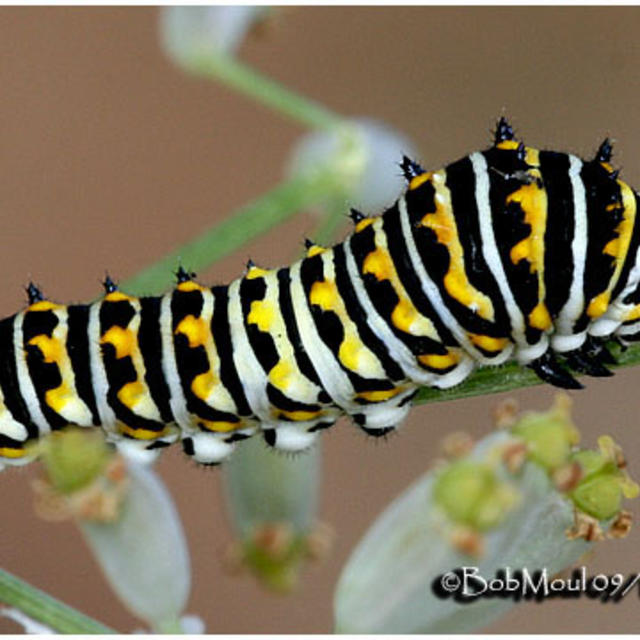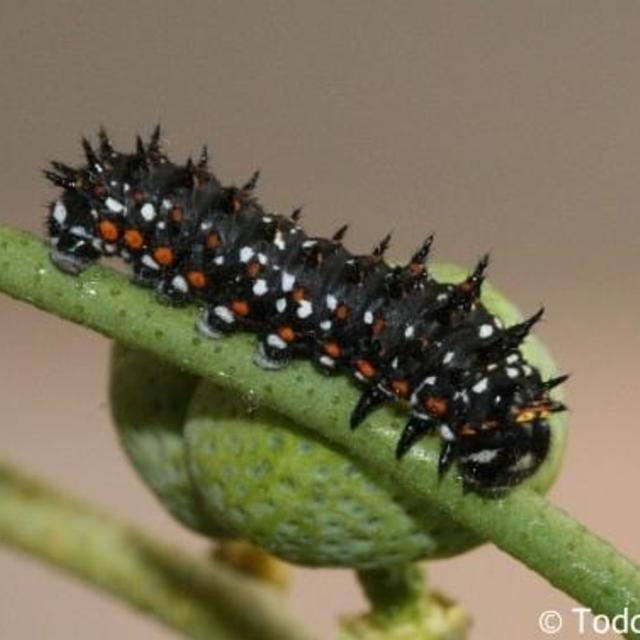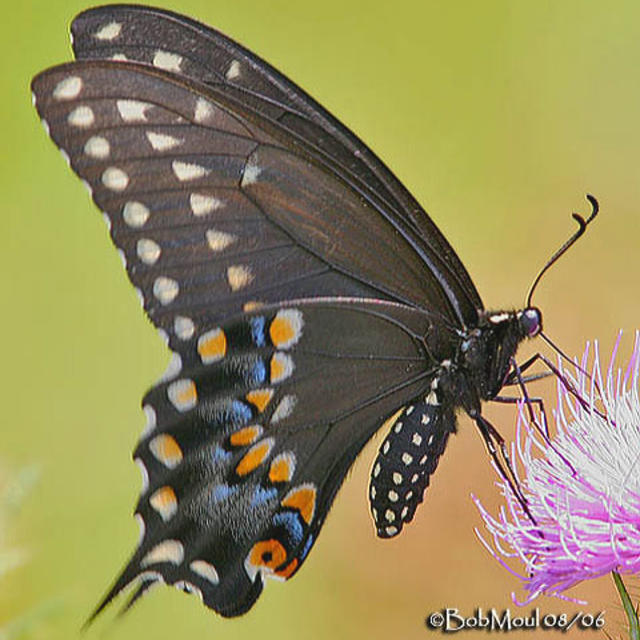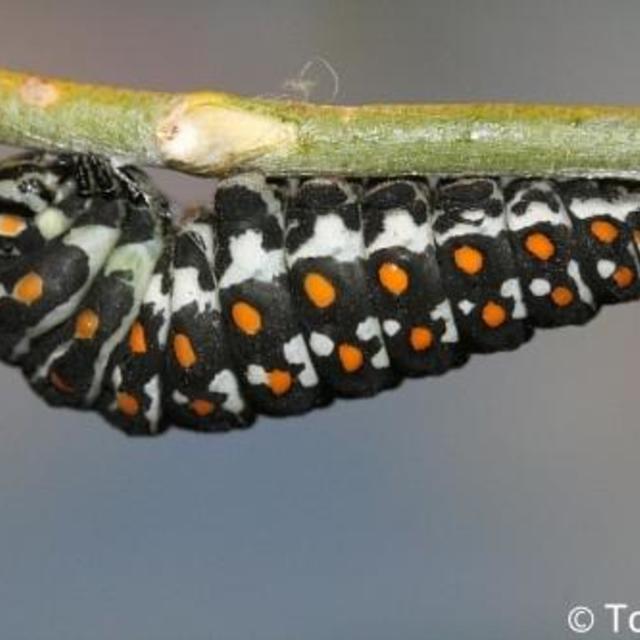Black Swallowtail
Papilio polyxenes Fabricius, 1775
Family: Papilionidae
Subfamily: Papilioninae
Identification: Upper surface of wings mostly black; on inner edge of hindwing is a black spot centered in larger orange spot. Male has yellow band near edge of wings; female has row of yellow spots. Female hindwing with iridescent blue band. In the Southwest, yellow forms predominate in the subspecies P. coloro.
Wing Span: 3 1/4 - 4 1/4 inches (8 - 11 cm).
Life History: Males perch and patrol for receptive females. Female lays eggs singly on leaves and flowers of the host, which are then eaten by hatching larvae. Hibernates as a chrysalis.
Flight: One-2 flights from April-October in northern regions of range; 3 flights in southern regions.
Caterpillar Hosts: Leaves of plants in the parsley family (Apiaceae) including Queen Anne's Lace, carrot, celery and dill. Sometimes plants in the citrus family (Rutaceae) are preferred.
Adult Food: Nectar from flowers including red clover, milkweed, and thistles.
Habitat: A variety of open areas including fields, suburbs, marshes, deserts, and roadsides.
Range: Most of the eastern U.S., north into Quebec, west into s. Saskatchewan, Colorado and se. California; south to n. South America. Subspecies coloro in desert Southwest.
Conservation: Not usually of concern.
NCGR: G5 - Demonstrably secure globally, though it may be quite rare in parts of its range, especially at the periphery.
Management Needs: Maintain open fields in East.
Get your BAMONA Gear!
Please donate!
We depend on donations to keep Butterflies and Moths of North America freely available. We want to express our gratitude to all who showed their support by making a contribution this year. You can donate to support this project at any time.
Advertise with us!
Do you have a product or service that you think would interest BAMONA users? If you would like to advertise on this website, contact us by email, or use the contact form and select the "Advertising" category.
Verified Sightings
Displaying 1 - 24 of 9633 verified sightings
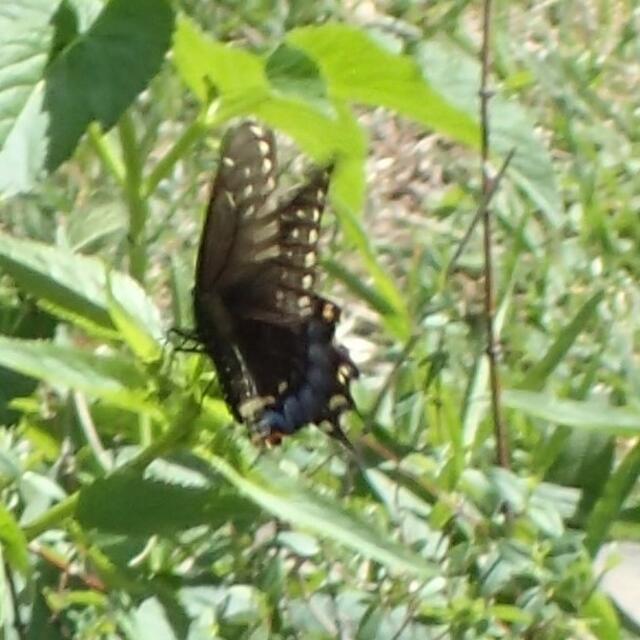
Observation date: Apr 16, 2024
Submitted by: seemayer
Region: Sedgwick County, Kansas, United States
Verified by: James Steen
Verified date: Apr 17, 2024
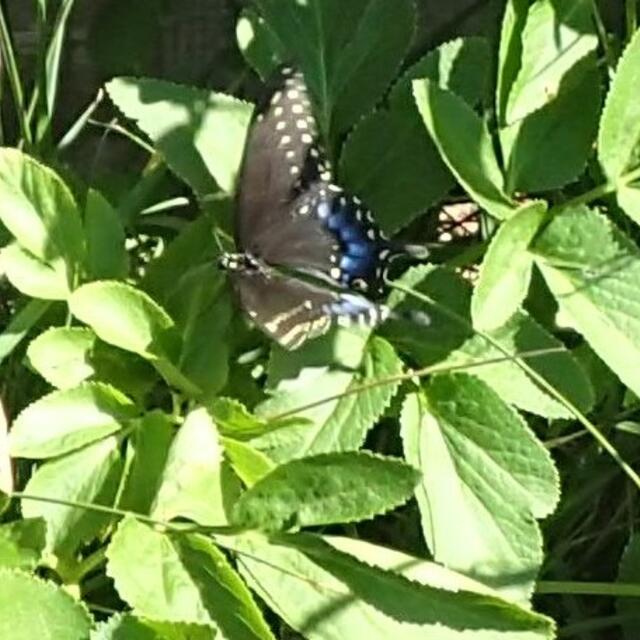
Observation date: Sep 09, 2023
Submitted by: seemayer
Region: Sedgwick County, Kansas, United States
Verified by: James Steen
Verified date: Apr 01, 2024

Observation date: Mar 11, 2024
Submitted by: TLee58flyinflowers
Region: Fayette County, Georgia, United States
Verified by: Mikelchap
Verified date: Mar 13, 2024

Observation date: Aug 18, 2023
Submitted by: terrymortier
Region: Crawford County, Wisconsin, United States
Verified by: jmgesell
Verified date: Mar 08, 2024

Observation date: May 07, 2023
Submitted by: Ken Cheeks
Region: Richmond County, Georgia, United States
Verified by: Mikelchap
Verified date: Mar 02, 2024

Observation date: Feb 09, 2024
Submitted by: jmgesell
Region: Sarasota County, Florida, United States
Verified by: John Calhoun
Verified date: Feb 10, 2024

Observation date: Aug 31, 2023
Submitted by: mostlynative
Region: Cuyahoga County, Ohio, United States
Verified by: rogerdowner
Verified date: Dec 08, 2023

Observation date: Aug 27, 2023
Submitted by: sgguthart
Region: Larimer County, Colorado, United States
Verified by: mikefisher
Verified date: Dec 05, 2023

Observation date: Oct 17, 2023
Submitted by: mtobin11
Region: Lake County, Illinois, United States
Verified by: rogerdowner
Verified date: Nov 26, 2023

Observation date: Jul 20, 2023
Submitted by: jcarter
Region: Nova Scotia, Canada
Verified by: jmgesell
Verified date: Oct 23, 2023

Observation date: Oct 15, 2023
Submitted by: pjohnson_cbap
Region: Middlesex County, Massachusetts, United States
Verified by: jwileyrains
Verified date: Oct 16, 2023

Observation date: Oct 06, 2023
Submitted by: cp2023
Region: Fairfield County, Connecticut, United States
Verified by: jwileyrains
Verified date: Oct 07, 2023

Observation date: Oct 04, 2023
Submitted by: Beverly Wolterbeek
Region: Los Angeles County, California, United States
Verified by: Ken Davenport
Verified date: Oct 05, 2023

Observation date: Oct 03, 2023
Submitted by: Don Marotte
Region: Rockingham County, New Hampshire, United States
Verified by: John Calhoun
Verified date: Oct 03, 2023

Observation date: Jun 11, 2023
Submitted by: LauEBSmx
Region: Mexico, Mexico
Verified by: Paul Prappas
Verified date: Sep 28, 2023

Observation date: Sep 21, 2023
Submitted by: jwileyrains
Region: Litchfield County, Connecticut, United States
Verified by: jwileyrains
Verified date: Sep 21, 2023

Observation date: Jul 02, 2017
Submitted by: Puccini
Region: Marshall County, South Dakota, United States
Verified by: J_Martineau
Verified date: Sep 21, 2023

Observation date: Aug 29, 2023
Submitted by: mtobin11
Region: Cook County, Illinois, United States
Verified by: rogerdowner
Verified date: Sep 20, 2023

Observation date: Jul 05, 2023
Submitted by: Dobber31
Region: Benton County, Arkansas, United States
Verified by: CA Ivy
Verified date: Sep 18, 2023

Observation date: Jul 16, 2023
Submitted by: ezeemonee
Region: El Paso County, Colorado, United States
Verified by: mikefisher
Verified date: Sep 17, 2023

Observation date: Sep 12, 2023
Submitted by: jwileyrains
Region: Litchfield County, Connecticut, United States
Verified by: jwileyrains
Verified date: Sep 12, 2023

Observation date: Aug 11, 2023
Submitted by: mtobin11
Region: Lake County, Illinois, United States
Verified by: rogerdowner
Verified date: Sep 11, 2023

Observation date: Sep 07, 2023
Submitted by: DeepSkyKelly
Region: Mora County, New Mexico, United States
Verified by: stevecary
Verified date: Sep 08, 2023

Observation date: Aug 28, 2023
Submitted by: ridgeboy
Region: Polk County, Florida, United States
Verified by: John Calhoun
Verified date: Sep 05, 2023
- 1 of 402
- next ›










